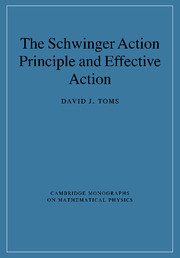Book contents
- Frontmatter
- Contents
- Preface
- 1 Action principle in classical mechanics
- 2 Action principle in classical field theory
- 3 Action principle in quantum theory
- 4 The effective action
- 5 Quantum statistical mechanics
- 6 Effective action at finite temperature
- 7 Further applications of the Schwinger action principle
- 8 General definition of the effective action
- Appendix 1 Mathematical appendices
- Appendix 2 Review of special relativity
- Appendix 3 Interaction picture
- Bibliography
- Index
Preface
Published online by Cambridge University Press: 27 October 2009
- Frontmatter
- Contents
- Preface
- 1 Action principle in classical mechanics
- 2 Action principle in classical field theory
- 3 Action principle in quantum theory
- 4 The effective action
- 5 Quantum statistical mechanics
- 6 Effective action at finite temperature
- 7 Further applications of the Schwinger action principle
- 8 General definition of the effective action
- Appendix 1 Mathematical appendices
- Appendix 2 Review of special relativity
- Appendix 3 Interaction picture
- Bibliography
- Index
Summary
Then Jurgen mounted this horse and rode away from the plowed field wherein nothing grew as yet. As they left the furrows they came to a signboard with writing on it, in a peculiar red and yellow lettering. Jurgen paused to decipher this.
‘Read me!’ was written on the signboard: ‘read me, and judge if you understand! So you stopped in your journey because I called, scenting something unusual, something droll. Thus, although I am nothing, and even less, there is no one that sees me but lingers here. Stranger, I am a law of the universe. Stranger, render the law what is due the law!’
Jurgen felt cheated. ‘A very foolish signboard, indeed! for how can it be ‘a law of the universe’, when there is no meaning to it!’ says Jurgen. ‘Why, for any law to be meaningless would not be fair.’
(James Branch Cabell)The quantum theory of fields is now a mature and well-developed subject with a wide range of applications to physical systems. The predominant approach that is taught to students today is the Feynman path integral. There is another approach that receives much less attention due to Schwinger, and his method is the main emphasis of the present book.
The intention of this book is to present the material in a manner that is accessible to final-year undergraduates or beginning postgraduate students.
- Type
- Chapter
- Information
- The Schwinger Action Principle and Effective Action , pp. x - xiiPublisher: Cambridge University PressPrint publication year: 2007



